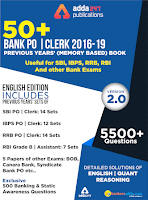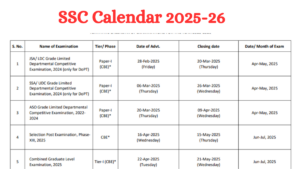Reasoning Questions for SBI CLERK MAINS 2019
Reasoning Ability is a crafty section. With each passing year, all the organizations are increasing the level of complexity of the questions that are asked in either prelims or mains. It eventually affects the number of question one can usually attempt. But this section is based on logic and rules can be aced if practised well enough. The only way to achieve this ambitious goal is by practising continuously with dedication. So to prepare you with best tools for the finals, here is today’s Reasoning Quiz based on the study plan and the exact same pattern of questions that are expected to be asked in SBI Clerk MAINS 2019. Keep Practicing. All the best.
Directions (1-5): Read the given information carefully and answer the given questions.
Six players are belonging to different cities. All of them Plays different games. Each player has different weight. S’s weight is more than only 2 persons and he belong to Kochi. The one who belongs to Jaipur has weight which is more than T’s weight but less than U’s weight. The one who likes Cricket, belongs to Jaipur. R doesn’t like Cricket. P’s weight is more than R but less than Q. Q belongs to Pune and T likes Hockey. The one, who is heaviest, has 85kg weight and likes Badminton. T is not the person who has lowest weight. U doesn’t like Badminton. The one who likes Kabaddi doesn’t belong to Kochi and he is not the person who has second highest weight. P’s weight is 60kg. The one who has 75kg weight and likes Tennis and belongs to Lucknow. R doesn’t belong to Mumbai. The one who has lowest weight is 48kg. The one who belongs to Kolkata does not play football.
Q1. Who among the following persons belongs to Kolkata?
S
Q
R
P
None of these
Q2. Who among the following person is 75kg?
Q
U
R
P
None of these
Q3. How many persons are lighter than Q?
None
Two
Four
Five
Three
Q4. The one who plays badminton belongs to which city?
Pune
Jaipur
Mumbai
Lucknow
None of these
Q5. The person who is lightest in the group plays which of the following games?
Cricket
Kabaddi
Tennis
Football
None of these
Directions (6-10): Study the following information carefully to answer the given questions.
A word and number arrangement machine when given an input line of words and numbers rearranges them following a particular rule in each step. The following is an illustration of input and rearrangement.
Input: first 31 practice linear 22 47 sound 11 62 magic 35
Step I: 11 first 31 practice linear 22 47 sound 62 35 magic
Step II: 11 31 first practice linear 22 47 62 35 sound magic
Step III: 11 31 47 first linear 22 62 35 practice sound magic
Step IV: 11 31 47 22 first 62 35 linear practice sound magic
Step V: 11 31 47 22 35 62 first linear practice sound magic
And step V is the last step of the above input. As per the rules followed in the above step, find out the appropriate step for the given output.
Input: wait 17 48 bad back 23 relation 61 25 puzzle 16
Q6. Which element is exactly between the third element from left end and fifth element from right end in step IV?
48
back
wait
bad
16
Solution:
In this input output question two numbers are arranged in each step following a certain pattern. Let us understand the logic behind it-
For Words: Words are arranged according to the place value of the last letter in the alphabetical series from right to left in the right end. The word which has the last letter, which comes 1st in alphabetical series, is arranged first and so on. For example, “music and guide” in which we can see that “c” and “e” are last letters of both words but c comes 1st, so “music” will be arranged 1st.
For Numbers: They are arranged in increasing order. The prime numbers are arranged first followed by composite numbers from left to right in left end.
Input: wait 17 48 bad back 23 relation 61 25 puzzle 16
Step I: 17 wait 48 back 23 relation 61 25 puzzle 16 bad
Step II: 17 23 wait 48 back relation 61 25 16 puzzle bad
Step III: 17 23 61 wait 48 relation 25 16 back puzzle bad
Step IV: 17 23 61 16 wait 48 25 relation back puzzle bad
Step V: 17 23 61 16 25 48 wait relation back puzzle bad
Q7. In step II, '17' is related to 'back' and 'wait' is related to '61'. In the same way 'relation' is related to?
25
bad
23
puzzle
48
Solution:
In this input output question two numbers are arranged in each step following a certain pattern. Let us understand the logic behind it-
For Words: Words are arranged according to the place value of the last letter in the alphabetical series from right to left in the right end. The word which has the last letter, which comes 1st in alphabetical series, is arranged first and so on. For example, “music and guide” in which we can see that “c” and “e” are last letters of both words but c comes 1st, so “music” will be arranged 1st.
For Numbers: They are arranged in increasing order. The prime numbers are arranged first followed by composite numbers from left to right in left end.
Input: wait 17 48 bad back 23 relation 61 25 puzzle 16
Step I: 17 wait 48 back 23 relation 61 25 puzzle 16 bad
Step II: 17 23 wait 48 back relation 61 25 16 puzzle bad
Step III: 17 23 61 wait 48 relation 25 16 back puzzle bad
Step IV: 17 23 61 16 wait 48 25 relation back puzzle bad
Step V: 17 23 61 16 25 48 wait relation back puzzle bad
Q8. In which of the following step the elements “48 25 relation” found in the same order?
Step I
Step IV
Step III
Step II
no such step
Solution:
In this input output question two numbers are arranged in each step following a certain pattern. Let us understand the logic behind it-
For Words: Words are arranged according to the place value of the last letter in the alphabetical series from right to left in the right end. The word which has the last letter, which comes 1st in alphabetical series, is arranged first and so on. For example, “music and guide” in which we can see that “c” and “e” are last letters of both words but c comes 1st, so “music” will be arranged 1st.
For Numbers: They are arranged in increasing order. The prime numbers are arranged first followed by composite numbers from left to right in left end.
Input: wait 17 48 bad back 23 relation 61 25 puzzle 16
Step I: 17 wait 48 back 23 relation 61 25 puzzle 16 bad
Step II: 17 23 wait 48 back relation 61 25 16 puzzle bad
Step III: 17 23 61 wait 48 relation 25 16 back puzzle bad
Step IV: 17 23 61 16 wait 48 25 relation back puzzle bad
Step V: 17 23 61 16 25 48 wait relation back puzzle bad
Q9. In step II, what is the sum of fourth element from left end and third element from right end?
79
88
37
80
64
Solution:
In this input output question two numbers are arranged in each step following a certain pattern. Let us understand the logic behind it-
For Words: Words are arranged according to the place value of the last letter in the alphabetical series from right to left in the right end. The word which has the last letter, which comes 1st in alphabetical series, is arranged first and so on. For example, “music and guide” in which we can see that “c” and “e” are last letters of both words but c comes 1st, so “music” will be arranged 1st.
For Numbers: They are arranged in increasing order. The prime numbers are arranged first followed by composite numbers from left to right in left end.
Input: wait 17 48 bad back 23 relation 61 25 puzzle 16
Step I: 17 wait 48 back 23 relation 61 25 puzzle 16 bad
Step II: 17 23 wait 48 back relation 61 25 16 puzzle bad
Step III: 17 23 61 wait 48 relation 25 16 back puzzle bad
Step IV: 17 23 61 16 wait 48 25 relation back puzzle bad
Step V: 17 23 61 16 25 48 wait relation back puzzle bad
Q10. Which of the following element would be at the third from the left of the element which is sixth from the right end in step III?
61
wait
back
16
48
Solution:
In this input output question two numbers are arranged in each step following a certain pattern. Let us understand the logic behind it-
For Words: Words are arranged according to the place value of the last letter in the alphabetical series from right to left in the right end. The word which has the last letter, which comes 1st in alphabetical series, is arranged first and so on. For example, “music and guide” in which we can see that “c” and “e” are last letters of both words but c comes 1st, so “music” will be arranged 1st.
For Numbers: They are arranged in increasing order. The prime numbers are arranged first followed by composite numbers from left to right in left end.
Input: wait 17 48 bad back 23 relation 61 25 puzzle 16
Step I: 17 wait 48 back 23 relation 61 25 puzzle 16 bad
Step II: 17 23 wait 48 back relation 61 25 16 puzzle bad
Step III: 17 23 61 wait 48 relation 25 16 back puzzle bad
Step IV: 17 23 61 16 wait 48 25 relation back puzzle bad
Step V: 17 23 61 16 25 48 wait relation back puzzle bad
Direction (11-15): Study the following information carefully and answer the given questions.
There are eight members in a family in three generation i.e. P, Q, R, S, T, U, V and M. Among them only two married couples and only four males. R is married to P. Q is the only child of S. U is married and she has a mother-in-law. S is paternal grandmother of T. P is father of T’s mother and V. M is not a female member of a family. T is brother of M.
Q11. Who among the following mother of T?
S
P
V
U
None of these
Q12. Who among the following is sister-in-law of Q?
P
V
M
T
None of these
Q13. Who among the following is mother of V?
R
S
T
V
None of these
Q14. How is P related to Q?
Father
Mother
Father in law
Mother in law
None of these
Q15. How is R related to M?
Paternal grandfather
Maternal grandfather
Paternal grandmother
Maternal grandmother
None of these





 GA Capsule for SBI Clerk Mains 2025, Dow...
GA Capsule for SBI Clerk Mains 2025, Dow...
 The Hindu Review October 2022: Download ...
The Hindu Review October 2022: Download ...
 SSC Calendar 2025 Under Review, Dates So...
SSC Calendar 2025 Under Review, Dates So...





